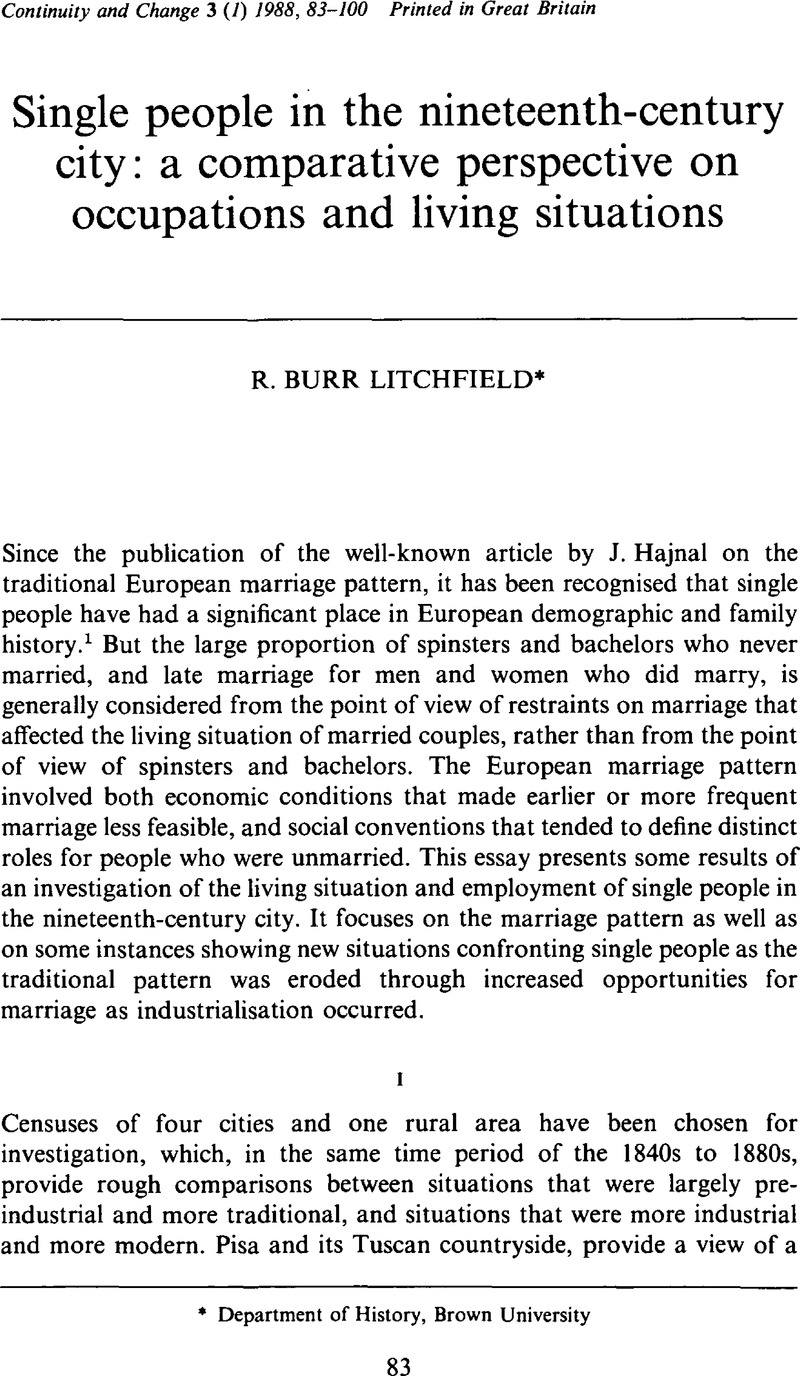Published online by Cambridge University Press: 29 January 2009

1 Hajnal, , ‘European marriage patterns in perspective’, in Glass, D. V. and Eversley, D. E. C., ed., Population in History (London, 1965).Google Scholar
2 The census data used in this essay is taken partly from material prepared for use in the project on Comparative Cities at Brown University by the author and H. P. Chudacoff. The enlarged samples are a 1:5 house samples for Pisa, 1:10 house samples for Amiens and the two central registration districts of Stockport, and approximately 1:20 house samples for Providence. To further enlarge the sample sizes sufficiently to focus on the situation of single people, samples from Amiens in 1851 and 1861, for Stockport in 1851 and 1861, and for Providence in 1875 (from the state census) and 1880 (from the U.S. Federal Census) were combined and analysed together. The census file is fully described in R. B. Litchfield, Comparative cities, available from the Data Archive of the Inter University Consortium for Social and Political Research, Ann Arbor, Michigan.
3 Hajnal, , ‘Age at marriage and the proportions marrying’ in Population Studies 7 (2) (1953), 111–36.CrossRefGoogle Scholar
4 These groupings do not correspond exactly to standard household types, although married people living as couples were always in nuclear households, and single people living alone or as hosts were all in the group described as ‘head alone or with non-kin’. For persons counted living as children, preference was given to the relationship with parents, or a parent, and some of these households also included kin.
5 Klapisch, C. and Demonet, M., ‘“A uno vino e uno pane”: La famille rurale Toscane au debut du XVe siècle,’ in Annales: Economies, Sociétés, Civilsations 27 4–5 (1972), 873–901.CrossRefGoogle Scholar
6 Hajnal, J., ‘Two kinds of pre-industrial household formation systems’, in Wall, Richard, ed., Family forms in historic Europe (Cambridge, 1983).Google Scholar
7 The marital status of single people was not clearly indicated in the Catasto, resulting in a large proportion with indeterminate status. This seems to be a less serious problem in table 2 of Klapisch and Demonet's assessment of the Contado of Pisa where marital status was recorded. For a further discussion see Herlihy, D. and Klapisch, C., Les Toscans et leurs Families (Paris: Editions de l'Ecole Pratique des Hautes Etudes en Sciences Sociales, 1978), 400–4 and 398Google Scholar, where men of indeterminate status are assessed to have been for the most part unmarried, but women of indeterminate status to have been widows, suggesting that there was a small proportion of never-married women, but a large proportion of unmarried men. Thus the small proportion of unmarried men reported in the Contado of Pisa may not have been typical of Tuscany as a whole, and the traditional marriage pattern may have applied to men in the fifteenth century, although not to women.
8 From Herlihy and Klapisch, Les Toscans, 405 it is clear that at the time of the Catasto there were larger proportions of unmarried men and women in urban than in small town and rural areas.
9 Gozzini, G., ‘Matrimonio e mobilità sociale a Firenze nel primo '800,’ in Quaderni Storici 57 (XIX), 3 (1984), 907–35.Google Scholar
10 On the pattern at Amiens see Litchfield, R. B. and Gordon, D., ‘Closing the “Tour”: a close look at the marriage market, unwed mothers, and abandoned children in mid-nineteenth-century Amiens’, in Journal of Social History, 13, 3 (1980), 458–72.CrossRefGoogle Scholar
11 The proportion of nuclear households in the countryside and city of Pisa was 0.59 and 0.66. At Amiens, Stockport, and Providence the proportions were 0.70, 0.71, and 0.75. The corresponding proportion of heads alone or with non-kin were 0.04, 0.14, 0.18 (at Amiens), 0.06, and 0.05, while the proportions of extended or multiple households were 0.34, 0.15, 0.10, 0.20, and 0.17. The remainder were co-resident kin with no nuclear unit, or institutional arrangements.
12 See, for example, Fauve-Chamoux, A., ‘The importance of women in an urban environment: the example of Rheims households at the beginning of the Industrial Revolution,’ in Wall, , ed., Family forms in historic Europe.Google Scholar
13 Litchfield, and Gordon, , ‘Closing the “Tour”’Google Scholar; Walle, E. Van der, ‘Illegitimacy in France during the nineteenth century,’ in Laslett, P., Oosterveen, K. and Smith, R. M., eds., Bastardy and its comparative history (Cambridge, Mass., 1980).Google Scholar
14 Further on migration and marriage age at Providence see Chudacoff, H. P., ‘Newlyweds and family extension: the first stage of the family cycle in Providence, Rhode Island, 1864–1865 and 1879–1880’, in Hareven, T. K. and Vinovskis, M., eds., Family and population in 19th Century America (Princeton University Press, 1978).Google Scholar
15 Further on occupations at Stockport see Litchfield, R. B., ‘The family and the mill: cotton mill work, family work patterns and fertility in mid-Victorian Stockport,’ in Wohl, A. S., ed., The Victorian family: structure and stresses (London, 1978).Google Scholar